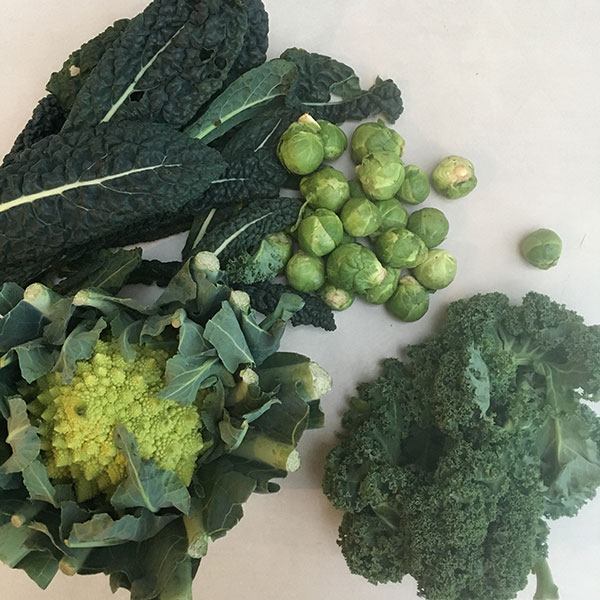
In the winter months, cruciferous vegetables such as broccoli, romanesco, cabbages, kale, cavolo nero, cauliflower, Brussels sprouts and leafy vegetables such as Swiss chard, are at their best and bursting with health-promoting nutrients. Try to buy from your local farmers market rather than gabbing a ready-to-eat bag from the supermarket to ensure maximum nutrient availability.
This post gives an overview of the nutrients they provide and how their support health as well as a few tips on how to cook them to maximise nutrients and, of course, taste!
Those dark green leafy veggies popping up at every market and the brassicas contain high levels of carotenoids which have amazing antioxidant properties and protect us from the harmful effects of free radicals generated by our body as well from external sources such as heavy metals in water and food, air pollution, smoking and alcohol.
Our body has some clever mechanisms to reduce the level of free radicals, all it needs is a good supply of antioxidants. When there are more free radicals than the antioxidants can zap, we enter oxidative stress that may interfere with our DNA metabolism and promote diseases such as cancer.
Antioxidants found in leafy greens and green colourful veggies in the Brassica family, i.e. not the lovely cauliflower, are beta-carotene and lutein / zeaxanthin which also help maintain healthy eyes.
Kale, a very fashionable veggie, contains the highest levels of these antioxidants with a generous handful giving more than 200% of what the recommended daily intake. The colourful Swiss chard also provides significant amounts as does broccoli.
Our body converts carotenoids into vitamin A which enhances night vision and maintains healthy mucous membranes which in turn helps prevent infections – so great to prevent colds in the winter. Vitamin A is also necessary for the production of collagen which is essential for healthy looking skin and to recover after exercise and physical injuries as it is also an important component of our tendons, cartilages and bones.
These vegetables help maintain strong bones as they provide some calcium but also good amounts of vitamin K which plays an important role in bone mineralization.
Broccoli, cauliflower, cabbage and Brussels sprouts contain high levels of folic acid which plays an important role in the production of red blood cells and prevents spina bifida during pregnancy.
All these vegetables contain good amounts of vitamin C, especially kale, Brussels sprouts and broccoli that provide more than the recommended daily amount in just one helping. Vitamin C helps maintain our immune system healthy and is also necessary to maintain our adrenal glands running smoothly especially during periods of stress.
These vegetables also contain compounds called glucosinolates that when consumed regularly, research has linked to a lower incidence of cancer.
Note however that the brassica family vegetables are goitrogenic in large quantities, which means they may interfere with our thyroid function and decrease the levels of hormones we produce. Normal amounts of this vegetables in a balanced diet, especially if consumed cooked, are unlikely to affect the levels of thyroid hormones produced.
We usually eat broccoli, cabbage, chard, etc. cooked so it is best to avoid boiling them and instead lightly steam them, add them to stews and soups or roast them in the oven at low temperature to prevent vitamin C leaching into the cooking liquid. If you do boil them, use the cooking water as stock for a vitamin C- rich soup.
Lightly fry a couple of minced garlic cloves and a 2 cm piece of grated ginger in rapeseed oil.
After 2-3 min add a head of broccoli (florets separated and stalk trimmed and cut in batons), fry stirring all the time for a minute and then add a couple of tablespoonfuls of water, clamp the lid on and cook for a couple of minutes. Repeat this process until the broccoli is “al dente”.
Before serving, add a splash of soy sauce, some toasted sesame seeds and a little sesame oil.
Heat a couple of tablespoons of refined olive oil and lightly fry 1 clove of garlic (well minced) and two anchovy fillets (stir them into the oil until they melt).
Once the garlic is soft, add the Swiss chard freshly cut into 2cms pieces with still some water clinging to the leaves so the temperature of the oil drops which helps preserve nutrients.
As the green wilt, keep adding more and stirring so they cook evenly. You can add a little more water if the pan is stating to look dry.
A few minutes before finishing the cooking, add a handful of good quality olives and a few crushed toasted almonds. Season to taste.
Kale is delicious cut into 3cm pieces, seasoned with a little soy sauce and sesame seeds and baked in a warm oven (140C fan) for about 8-10 minutes.
Cooked this way, kale is super crispy and works a treat as a snack for kids and grown-ups.
The trick is to wash and completely dry the kale beforehand, then add one (or two) tablespoons of dressing and massage onto the leaves until well distributed but without leaving the kale soggy (it won’t crisp up if too wet).
Spread the kale pieces in a single layer on a baking sheet and bake for 8-10min. Remove those chips that are already crispy, give them remaining ones a good shake and bake a few minutes longer.